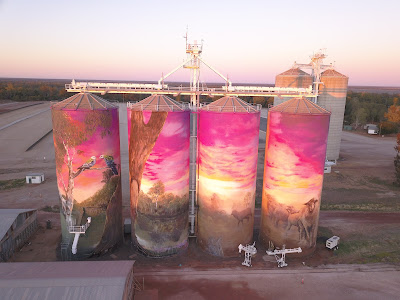After leaving Port Fairy, we headed north-east towards Ballarat. We spent the following evening camping at the Newstead racecourse and recreation ground, 17 km south-west of Castlemaine. It's also listed in WikiCamps, and your $10 fee per night includes showers, toilets, fresh water, and a dump point.
Our following day of travel continued through Bendigo and towards the Strathbogie Ranges. We were there to spend the evening with friends on their property at Strathbogie. A lovely meal, including many bottles of red wine, saw us eventually head to bed quite late.
From here, we continued through Euroa before joining the Hume Freeway to Benalla and our campsite for the next two nights.
We are spending two days camped at Broken Creek bush camp, 16 km north-west of Benalla. Fees are just $7.50 per person, which includes showers, toilets, freshwater, and a dump point. This site is listed in Wiki Camps.
Four towns in northeastern Victoria have now painted their silos to form their own silo art trail.
Tungamah, Devenish, St James and Goorambat are all less than 50 kilometres apart.
Our campsite is near these four towns, so a day trip to photograph these silos was planned. We were surprised that all these silos were behind fences, preventing us from getting up close and personal, unlike the silos in the Wimmera. We started the trail in Tungamah since it was the furthest town from where we were staying.
Then it was south towards St James, where one of the silos was still in the process of being painted.
Our favourite silos were in Devenish, showing two servicewomen a century apart.
Apart from the silos in Goorambat, the local Uniting Church has a mural on its interior wall painted by street artist Adnate, who also painted the beautiful silos at Sheep Hills.
We enjoyed a lovely lunch in Benalla and took photos of some local street art.
Before leaving Victoria, there was just one more silo to photograph. This was in the town of Rochester, just south of Echuca.























































